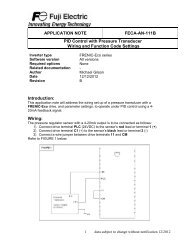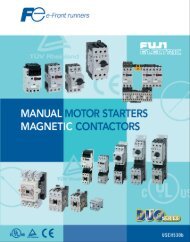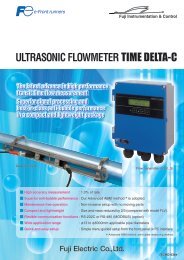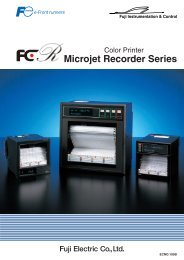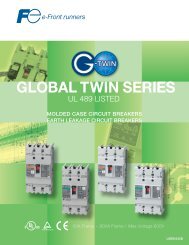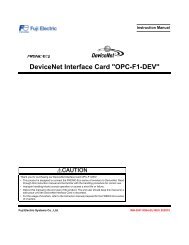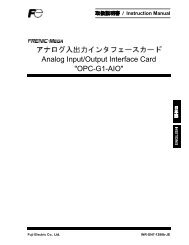RS-485 User's Manual MEH448d - Fuji Electric America
RS-485 User's Manual MEH448d - Fuji Electric America
RS-485 User's Manual MEH448d - Fuji Electric America
You also want an ePaper? Increase the reach of your titles
YUMPU automatically turns print PDFs into web optimized ePapers that Google loves.
2.2.4 Measures against noise<br />
Depending on the operating environment, normal communications cannot be performed or<br />
instruments and converters on the host side may malfunction due to the noise generated by the<br />
inverter. This section describes measures to be taken against such problems. Consult Appendix<br />
A "Advantageous Use of Inverters (Notes on electrical noise)" in <strong>User's</strong> <strong>Manual</strong> of each inverter<br />
type.<br />
[1] Measures for devices subjected to noise<br />
Using an isolated converter<br />
An isolated converter suppresses common mode noise that exceeds the specified operating<br />
voltage range of the receiver in case of long-distance wiring. However, since the isolated<br />
converter itself may malfunction, use a converter insusceptible to noise.<br />
Using a category 5 compliant LAN cable<br />
Category 5 compliant LAN cables are generally used for <strong>RS</strong>-<strong>485</strong> communications wiring. To<br />
obtain an improved preventive effect on electromagnetically induced noise, use Category 5<br />
conformed LAN cables with four twisted-pair-cores and apply one twisted pair, DX+ and DX-. To<br />
ensure a high preventive effect on electrostatically induced noise, use Category 5 conformed<br />
LAN cables with four shielded-and-twisted-pair-cores, and ground the shield at the master-side<br />
end.<br />
Effect of twisted pair cables<br />
A uniform magnetic flux directing from the face to back of the paper exists, and if it increases,<br />
electromotive force in the direction of → is generated. The electromotive forces of A to D are the same<br />
in intensity, and their directions are as shown in the above figure. In the cable DX+, the direction of<br />
electromotive forces B is reverse to that of electromotive force C, then the electromotive forces B and C<br />
offset each other, and so do electromotive forces A and D in the cable DX-. So, normal mode noise<br />
caused by electromagnetic induction does not occur. However, noise cannot be completely suppressed<br />
under such conditions as an uneven twist pitch. In the case of twisted cables, the normal mode noise is<br />
considerably reduced. But in the case of parallel cables, there may be a case where noises are not<br />
sufficiently reduced.<br />
Shield effect<br />
1) When the shield is not grounded,<br />
the shield functions as an antenna and receives noise.<br />
2) When the shield is grounded at both ends,<br />
if the grounding points are separated from each other, the ground potential may be different between<br />
them, and the shield and the ground form a loop circuit in which a current flows and may cause noise.<br />
Additionally, the magnetic flux within the loop may vary and generate noise.<br />
3) When the shield is grounded at either end,<br />
the effect of electrostatic induction can be completely eliminated within the shielded section.<br />
Connecting terminating resistors<br />
Insert a resistor equivalent to the characteristic impedance of the cables (100 to 120Ω) into both<br />
end terminals of the wiring (network) to prevent ringing due to the reflection of signals.<br />
Separating the wiring<br />
Separate the power lines (input L1/R, L2/S, and L3/T and output U, V, and W) from the <strong>RS</strong>-<strong>485</strong><br />
communications line, because induced noise can be prevented.<br />
2-16



